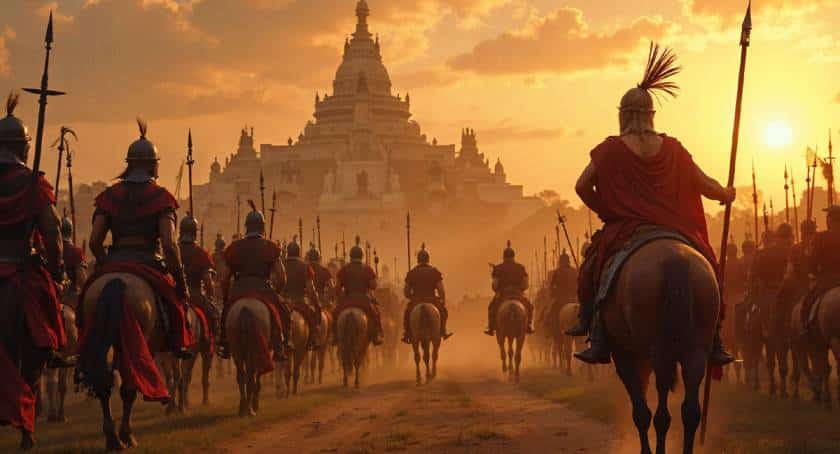Kalinga Empire: Odisha’s Historical Significance
The Kalinga Empire, an ancient and powerful kingdom in present-day Odisha, holds immense historical significance in India’s past. Known for its fierce warriors, thriving maritime trade, and profound cultural impact, Kalinga played a crucial role in shaping India’s history. This article examines its legacy, ascent to power, conflict with the Mauryan Empire, and enduring impact on Odisha’s culture and traditions.
The Rise of Kalinga
The Kalinga Empire thrived around the 3rd century BCE, strategically occupying a prime location along India’s eastern coast. Its advantageous position enabled it to become a significant commercial and maritime trade center. The kingdom had a well-structured administrative system, a strong military, and a prosperous economy, contributing to its rise as a formidable power.
Kalinga was widely known for its extensive trade networks that connected India with Southeast Asia. Merchants from Kalinga exported textiles, spices, ivory, and precious stones to regions such as Sri Lanka, Burma, and Indonesia. The empire’s maritime prowess allowed it to establish strong diplomatic and trade relations with these regions, spreading Indian culture and influence beyond its borders.
Apart from trade, Kalinga also developed a distinct cultural identity. The region was known for its art, literature, and architectural advancements. The people of Kalinga were profoundly spiritual and embraced various religious traditions, including Hinduism, Jainism, and Buddhism, which flourished in the region.
The Kalinga War and Ashoka’s Transformation
One of the most significant events in Indian history was the Kalinga War in 261 BCE. The Mauryan emperor Ashoka sought to conquer Kalinga to expand his dominion, leading to a brutal conflict. Despite their valiant resistance, the invaders ultimately defeated the Kalingans. However, the war had profound consequences for both the victors and the vanquished.
The immense loss of life and suffering witnessed during the war deeply affected Ashoka. Historical accounts suggest that over 100,000 people perished, and many more were displaced. The sight of widespread devastation led Ashoka to experience a profound transformation. Overcome with remorse, he renounced violence and embraced Buddhism, dedicating his life to promoting peace and Dharma.
Following this transformation, Ashoka implemented policies focused on nonviolence, compassion, and social welfare. He spread Buddhist teachings across India and beyond, sending emissaries to regions such as Sri Lanka, Central Asia, and Southeast Asia. Thus, the Kalinga War marked a crucial turning point in Indian history, emphasizing the power of repentance and peace over military conquest.
Kalinga’s Cultural and Maritime Influence
Despite its defeat in the war, Kalinga retained its prominence as a hub of culture, art, and trade. The kingdom remained a major player in India’s maritime affairs. Kalinga’s seafarers and traders maintained strong connections with Southeast Asian countries, including Bali, Java, and Sumatra. These interactions led to the exchange of cultural and religious ideas, with many Indian customs, traditions, and architectural styles influencing local cultures in these regions.
Kalinga-style architecture became widely recognized for its intricate carvings and detailed sculptures. Temples and monuments built during this era showcased a unique artistic expression that blended spiritual themes with grandeur. Some of the most famous structures influenced by Kalinga’s architectural traditions include the Sun Temple of Konark and the Lingaraj Temple in Bhubaneswar. These temples remain iconic representations of Odisha’s rich architectural heritage and continue to attract historians and tourists alike.
Kalinga’s Role in Religion and Spirituality
Kalinga was a melting pot of religious traditions, significantly propagating Hinduism, Jainism, and Buddhism. The region served as a center for Buddhist learning, with numerous monks and scholars contributing to expanding Buddhist philosophy. Dhauli Hill, located near Bhubaneswar, is believed to be the site where Ashoka’s transformation took place. Today, it houses significant Buddhist stupas, rock edicts, and inscriptions commemorating this pivotal historical moment.
Hinduism also thrived in Kalinga, with people constructing many grand temples during this period. The Jagannath Temple in Puri, one of Hinduism’s four sacred Char Dhams, has its roots in the Kalinga era. Dedicated to Lord Jagannath, the temple remains a primary pilgrimage site, drawing millions of devotees annually. Puri’s famous Rath Yatra (Chariot Festival) originates from this temple and is a testament to the enduring spiritual traditions established by the Kalinga rulers.
Legacy and Modern-Day Significance of Kalinga
The legacy of the Kalinga Empire continues to shape Odisha’s identity and cultural heritage. Several institutions and awards bear the name ‘Kalinga,’ honoring its historical significance:
- Kalinga Institute of Social Sciences (KISS) – One internationally renowned organization that educates impoverished indigenous populations is the Kalinga Institute of Social Sciences (KISS).
- Kalinga Prize for the Popularization of Science – Awarded by UNESCO, this prestigious prize recognizes efforts to make science accessible to the public.
The Odisha government has also taken significant steps to preserve Kalinga’s rich heritage through restoration projects, museums, and tourism initiatives. Sites such as Dhauli, Ratnagiri, and Lalitgiri, known for their Buddhist and Jain influences, have been maintained and developed into historical and cultural attractions. These sites allow visitors to explore Kalinga’s glorious past and gain a deeper understanding of its contributions to Indian history.
Final Thoughts
The Kalinga Empire is a testament to Odisha’s resilience, cultural richness, and historical significance. Its role in shaping India’s spiritual transformation, maritime history, and architectural heritage is unparalleled. The Kalinga War and Ashoka’s subsequent transformation are profound lessons in history, emphasizing the impact of conflict, repentance, and the power of peace.
As we delve into Kalinga’s past, we honor its legacy and recognize its enduring influence on Odisha’s identity and global history. The temples, trade routes, and spiritual movements that emerged from this empire continue to inspire generations. Once the heartland of this mighty kingdom, Odisha remains a beacon of its glorious past, inviting the world to explore its profound history and heritage. The story of Kalinga is not just about battles and conquests but also about cultural resilience, artistic brilliance, and the triumph of peace over war. It remains a potent reminder of India’s past splendor and capacity to impact societies well beyond its boundaries.


